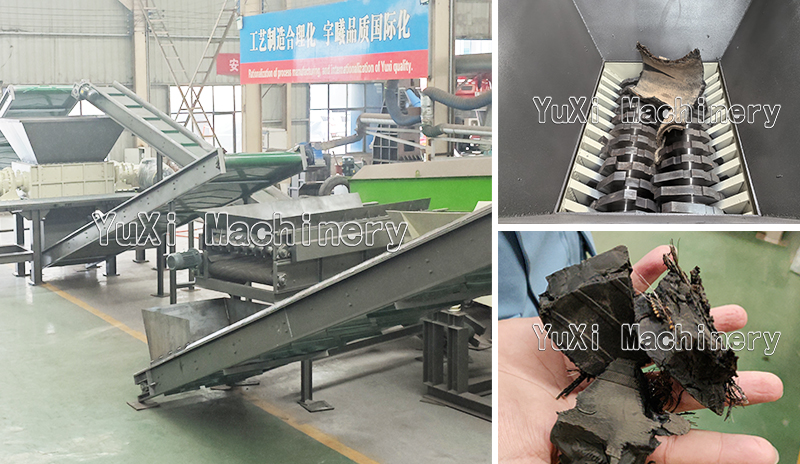In the mid-stream of waste tire recycling, there’s a piece of equipment responsible for turning “large chunks” into “uniform small materials” — it’s the waste tire dual-shaft shredder. Tire chunks pre-processed by cutting machines are further sheared into neat rubber pellets here, and unqualified materials are automatically screened for secondary shredding. It’s the core device that ensures recycled materials meet quality standards. Today, we’ll break down this “fine-shredding expert” in the tire recycling chain.
A waste tire dual-shaft shredder is an integrated shredding device (equipped with a 150HP motor) designed specifically for tire recycling — it combines a “dual-shaft shredding unit” and a “disc screening system” into one: the dual-shaft counter-rotating shearing system handles “shredding tire materials,” while the disc screen sorts “material sizes.” Unqualified materials are automatically recycled for secondary shredding.
It solves two key pain points in tire recycling: first, “tire materials are too large for subsequent equipment to handle”; second, “shredding is incomplete, resulting in uneven material chunks.” With this device, not only is shredding efficiency improved, but the output materials are more uniform, making them better suited for subsequent steel wire separation or rubber powder processing.

The processing range of dual-shaft tire shredders is broader than you might think. They don’t just handle waste tires; they can process various rubber scraps:
Simply put: As long as it’s a “waste rubber material,” it can basically be fed into this device — it’s a “versatile shredder” for rubber recycling.
Its workflow is a closed loop of “shredding + screening + recycling,” fully automated with no manual intervention required:
1.Material Feeding: “Send” the Material into the Machine
Whether it’s pre-processed tire chunks or rubber scraps, they’re fed into the device through the feed inlet — the inlet size is compatible with most pre-processed materials, so no additional cutting is needed before feeding.
2.Dual-Shaft Shredding: Shear the Material Like “Scissors”
The dual shafts rotate synchronously in opposite directions, paired with AISI D2 wear-resistant alloy blades, to perform primary shear-tear shredding on the feed. This dual-shaft design is critical: the counter-rotating blades “grip” the material chunks, preventing jams while thoroughly shredding steel-wire tire materials.
3.Recycling & Screening: Unqualified Materials “Automatically Recycle”
Shredded materials enter a disc screen (with screening precision up to 10mm), which separates “size-qualified materials” from “oversized unqualified materials.” Unqualified materials are automatically returned to the shredder’s feed inlet via the recycling system for secondary shredding.
4.Finished Product Discharge: Uniform Materials “Go Straight to the Next Process”
Qualified materials after screening are discharged from the outlet and directly sent to subsequent processes (such as steel wire separation or rubber powder processing). At this point, the previously uneven tire materials are transformed into uniform small pellets.

They become the “mixing core” of recycling lines thanks to these 3 key strengths:
1.Thorough Shredding: Uniform Chunks, No “Escaped Materials”
The combination of dual-shaft counter-rotation and disc screen recycling ensures “all materials are shredded to qualified sizes” — not only are the chunks uniform, but all unshredded materials are eliminated, so there’s no “large chunks mixed with small ones.”
2.Energy Efficiency & High Performance: Save Labor, Boost Speed, Cut Energy Use
Its automatic recycling system eliminates the need for manual sorting and rework — compared to traditional shredders, processing efficiency is 30% higher, and energy consumption is controlled within 120kW·h per ton, resulting in significant long-term electricity savings.
3.Durability: Handles “Tough Materials,” Longer Service Life
Blades are made of AISI D2 wear-resistant alloy (hardness HRC 58-62), and the body is welded from thick ASTM A36 steel — even with daily processing of steel-wire tire materials, wear is minimal. It can handle hard impurities in rubber (like steel wire ends or small metal pieces) without damage, and its service life is 2-3 times longer than ordinary shredders.
In Europe and the U.S., the use of dual-shaft shredders must meet strict environmental and safety requirements:

In the tire recycling chain, dual-shaft shredders play a critical “connecting” role:
As demand for refined rubber recycling grows, dual-shaft shredders are constantly upgrading: more wear-resistant blade materials, higher-precision disc screens, and smarter recycling systems (with automatic adjustment of recycling frequency) — they’ve evolved from “simple shredders” to “core devices that control material quality” in recycling lines.